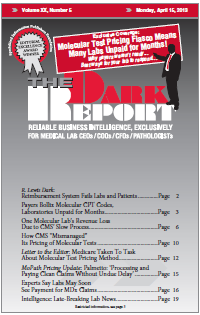EDITOR’S NOTE: Submitted by Lâle White, CEO of XIFIN, Inc., of Carlsbad, California, this letter describes the problems caused by the Medicare program’s failure, as of January 1, 2013, to be ready to process and reimburse lab test claims for more than 100 new molecular diagnostic CPT codes. Dear Editor: Everyone should read Scott Gottlieb, …
Medicare Taken to Task about Molecular Test Pricing Method Read More »
To access this post, you must purchase The Dark Report.


